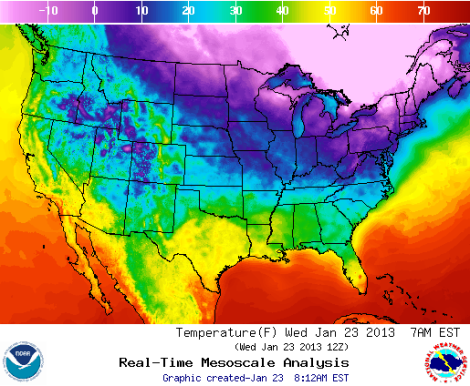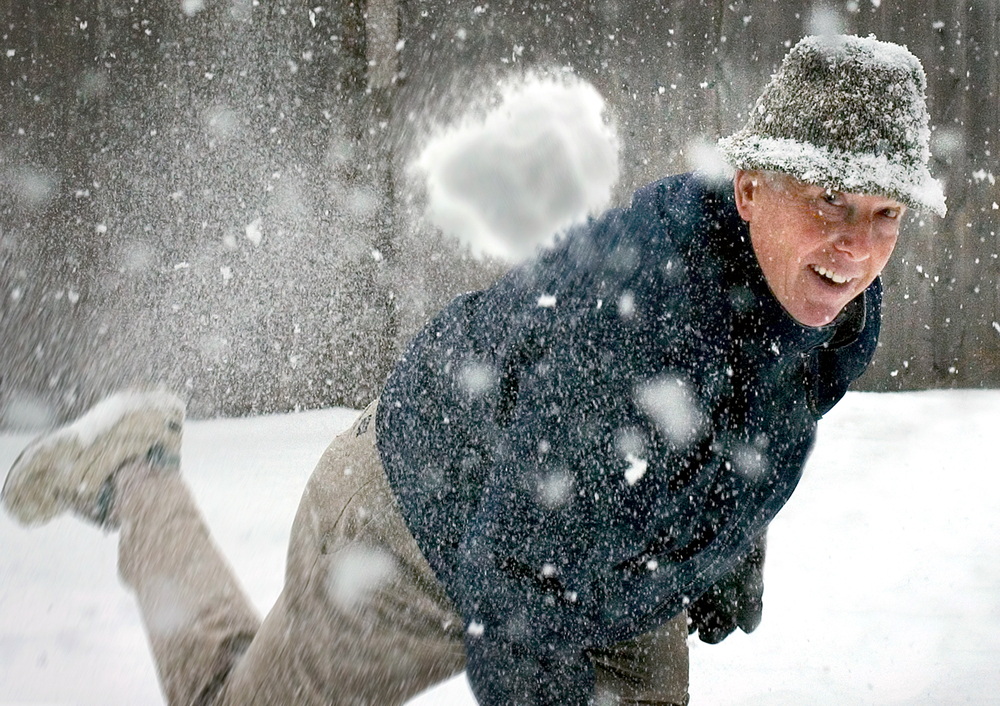
ShutterstockPrepare to get hit with the truth.
Those of you on the East Coast or who have access to the internet are likely aware that a severe cold snap has hit the region. It is affecting me personally, both because it is cold in my apartment and because my Twitter stream is now doubling as a real-time thermometer (with cursing).
What this means is that the opportunity is ripe for people who like to deny the existence of climate change to make stupid jokes. Some of these people will pull goofy stunts like building igloos, stunts which will land them a place in infamy among future generations. Other, lower-profile idiots will stop by your desk at work or email you or (God forbid) reach out on Facebook, saying something like “LOL what happenid to global warmeng??????” They will also mention Al Gore. Some will suggest you visit a thing called “Drudge Report”; do not do this.
As a general rule, it is not wise to engage with these people. They have already demonstrated that rationality is not a strong suit, so attempting to reason with them will only bring stress and pain to you both. But if you do want to engage with them — you have eight hours to kill; you are a masochist — we put together this handy, step-by-step guide for you to do so. Remember: speak slowly and, if necessary, draw pictures. The task before you makes Anne Sullivan’s look trivial.
Why abnormally cold weather doesn’t “disprove” global warming
1. It is winter. More specifically, it is January.
The person to whom you are speaking may have noticed over the course of his life that it always gets colder during the winter, at least for those of us unlucky enough to live far from the Equator. Average temperatures in New York City for January range in the low 30s. Right now it is colder than that, but warmer than the all-time low for the date: 2 degrees, set in 1976.
This happens, you should remind the person, because the Earth doesn’t rotate straight up and down. The Earth’s axis is tilted. So for part of the year as the Earth rotates around the Sun, the Southern Hemisphere is farther from the Sun than the Northern Hemisphere. When that happens, the Southern Hemisphere has shorter days and less sunshine, affecting the average temperature. Now, the opposite is true.
Now give them a little pat on the head by suggesting that if it were this cold in, say, July, they’d be right to find it suspicious. But thinking it’s weird that it’s very (but not exceptionally) cold in January is like being puzzled when water they put in the freezer turns to ice. Then ask them if they know how to make ice in a freezer. If they say no, just drop the whole thing.
2. There’s a weird weather pattern that’s making it colder than it would otherwise be.
Climate Central notes the unusual “stratospheric warming event” that is causing the current cold temperatures. Be warned: This will likely confuse and frighten the person with whom you’re speaking. Take it slow.
While the physics behind sudden stratospheric warming events are complicated, their implications are not: such events are often harbingers of colder weather in North America and Eurasia. The ongoing event favors colder and possibly stormier weather for as long as four to eight weeks after the event, meaning that after a mild start to the winter, the rest of this month and February could bring the coldest weather of the winter season to parts of the U.S., along with a heightened chance of snow.

NOAAHigh temperatures today
That may be too much for your audience. You can also try saying this, instead: “A sky thing is happening that doesn’t usually happen! It’s making it cold now, but it will go away.”
The key word to use is “unusual.” It is unusually cold because there is an unusual weather event. Ask the person you’re speaking with if they know what “unusual” means.
3. For advanced listeners only: Researchers expected a colder winter — thanks to global warming.
This summer saw the most extensive Arctic ice melt in recorded history. As it concluded, we noted that scientists expected that ice loss to translate to colder weather events. And, sure enough, from the Climate Central article linked above:
Sudden stratospheric warming events take place in about half of all Northern Hemisphere winters, and they have been occurring with increasing frequency during the past decade, possibly related to the loss of Arctic sea ice due to global warming. Arctic sea ice declined to its smallest extent on record in September 2012.
The “warming event” disturbs a pattern known as the “polar vortex.”
Sudden stratospheric warming events occur when large atmospheric waves, known as Rossby waves, extend beyond the troposphere where most weather occurs, and into the stratosphere. This vertical transport of energy can set a complex process into motion that leads to the breakdown of the high altitude cold low pressure area that typically spins above the North Pole during the winter, which is known as the polar vortex.
The polar vortex plays a major role in determining how much Arctic air spills southward toward the mid-latitudes. When there is a strong polar vortex, cold air tends to stay bottled up in the Arctic. However, when the vortex weakens or is disrupted, like a spinning top that suddenly starts wobbling, it can cause polar air masses to surge south, while the Arctic experiences milder-than-average temperatures.
Climate Central has a nifty animation of this happening. It may be easier to simply load that animation and point to it while nodding than trying to fight through the explanation above.
4. But most importantly: Weather is not climate.
It’s hard for all of us, dim-witted coworkers and relatives aside, to differentiate between a hot or cold day and the concept that the climate is changing over time. One of the best, clearest explanations of the difference comes from this now-famous video:
This week, that dog is dipping down into lower temperatures. But the planet keeps marching higher and higher, bringing all of us along with it.
Another way to think of it is using James Hansen’s analogy of loaded dice. Every day, the weather is the result of a roll of the dice. You could get a one. But more and more often, as the dice become more lopsided, you’re going to roll a six.
By this point in your argument, it is unlikely that your audience is still listening. He or she (it’s a he, isn’t it?) has glazed over, or has stormed off while yelling something about a Rush something or other, or has been trying to punch you for five to 10 minutes. There’s a tiny, remote possibility of a fourth response: a sudden, gradual nodding of the head, a request for more detail on one of the points you’ve raised. If this has happened, congratulations. You’ve done the unimaginable: changed a knee-jerk global warming denier into someone who accepts science.
The bad news is that you’ve used up an entire lifetime of luck in changing one mind. You probably should have just bought a lottery ticket.
Inspired by this tweet from Marshall Shepherd, the president of the American Meteorological Society.
Update: This post originally included a line about the Earth’s distance from the Sun that was an intentional oversimplification, but a dumb one, as (lots of) people have pointed out. I removed it. Your comments about irony and hubris are welcome.
Another update: I have further clarified that it’s not distance from the sun itself that matters, but how the tilt affects the amount of daylight. Apologies again for the imprecision.



